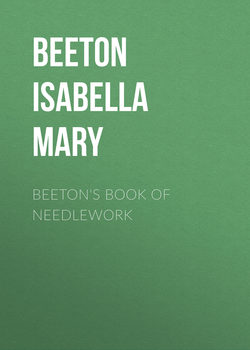Beeton's Book of Needlework

Реклама. ООО «ЛитРес», ИНН: 7719571260.
Оглавление
Beeton Isabella Mary. Beeton's Book of Needlework
SAMUEL BUTLER'S PREFACE
TATTING
TATTING INSTRUCTIONS
TATTING PATTERNS
EMBROIDERY
EMBROIDERY INSTRUCTIONS
EMBROIDERY
EMBROIDERY PATTERNS
CROCHET
CROCHET INSTRUCTIONS
CROCHET PATTERNS
KNITTING
KNITTING INSTRUCTIONS
NETTING
NETTING INSTRUCTIONS
KNITTING AND NETTING PATTERNS
MONOGRAMS AND INITIALS. ALPHABETS
MONOGRAMS AND INITIALS
POINT LACE WORK
POINT LACE INSRUCTIONS
POINT LACE PATTERNS
GUIPURE D'ART
INSTRUCTIONS AND PATTERNS IN GUIPURE D'ART
BERLIN WORK
BERLIN WORK INSTRUCTIONS
PLATES
Отрывок из книги
The needlework called Tatting in England, Frivolité in French, and Frivolitäten in German, is a work which seems, from all accounts, to have been in favour several generations ago. Modern ingenuity has discovered some ways of improving on the original plan of tatting, which was, indeed, rather a primitive sort of business as first practised. To Mrs. Mee, one of our most accomplished artistes in all matters connected with the work-table, belongs, we believe, the introduction of the plan of working from the reel instead of the shuttle. By this alteration the advantage of the shuttle being constantly kept filled with cotton was gained, and the necessity also obviated for frequently joining the thread; and to Mdlle. Riego, equally distinguished in all details appertaining to the employment of the needle, ladies are indebted for an arrangement by which the same thread used in the making of the pattern is used for fastening the work. The old plan only provided for the working of the different portions which constituted the pattern, and then these portions had to be sewn together with a needle and thread. The ingenious workers on the Continent have also given much attention of late to the art of tatting, and our instructions now printed comprise what we consider the best mode of learning and doing this exceedingly interesting and fashionable work.
Tatting differs entirely from crochet, and is composed of stitches forming knots. It is intended as an imitation of point lace, and is especially used for trimming under-linen, on account of its strength.
.....
The pretty effect of the insertion shown in illustration No. 32 is obtained by means of longer and shorter purl. Work as follows:–Join 9 double into a circle, 1 long purl, 3 double, 1 long purl, 4 double *. After an interval of five-eighths of an inch, begin the large figure of the pattern: 2 double, 1 small purl, 2 double, draw the cotton through the last purl of the small circle, 2 double, drawn through the 1st purl of the same circle, 2 double, 1 small purl, 2 double, 1 long purl, 2 double, 1 small purl, 2 double, repeat 6 times more from *, and draw up. After an interval of five-eighths of an inch comes another small circle: 4 double, draw the cotton through the last purl of the large figure, 3 double, draw the cotton through the next long purl of the same figure, 2 double, 1 long purl, 3 double, 1 long purl, 4 double. Repeat the pattern for the length of insertion required. The threads which join the small circles are worked over with 7 double in the manner described above, only the cotton at the principal figure must be left loose the width of a straw, so as to imitate a long purl. Complete the insertion from illustration by tatting round the small circles of 16 double on the other side (but in the contrary direction), form no purl, but draw the cotton through the long purl of the large figure; the threads which join the 2 circles are likewise drawn through the middle long purl of the large figure; this thread is then tatted over with 7 double, like the opposite outer edge.
Materials: If for couvrettes, Messrs. Walter Evans and Co.'s tatting cotton No. 20, or crochet cotton No. 4; tatting-pin No. 3. For d'oyleys, tatting cotton No. 50; tatting-pin No. 2. For headdresses, tatting cotton No. 80; tatting-pin No. 2.
.....